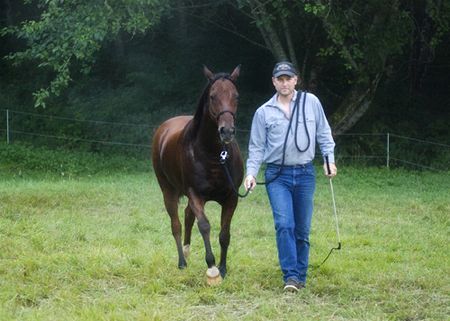Once the warmup has been achieved properly, there are many drills and exercises that can be carried out on the lunge.
Downward stretching
It is important to encourage a downward stretch in the horse’s neck and back as, like any athlete getting their body ready for use, this will safely prepare the horse for more work later on. Keep a light but firm contact down the lunge line to the horse’s head (use the lunge line in a similar style to your normal riding reins), and then release the contact slightly without giving it away all together. This will encourage the horse to drop its head forward and down toward the ground.
As this happens, play the contact again by bringing your elbow gently back toward your side and wriggling your hand slightly from the wrist as if landing a fish. This exercise will encourage the horse to stay in this lower position. It will be necessary to repeat the exercise again at the end of the lunging session as you stretch and cool the horse down.
Flexion exercise
A simple exercise for improving the horse’s flexion (flexibility) is to gradually increase and decrease the size of the circle the horse is working on. Do this by encouraging the horse to go forward in an active manner while shortening the lunge line by at least a foot to bring the horse onto a slightly smaller circle. Providing your body stays in the same place, this small change will adjust the horse’s way of going.
After approximately one circle, release the lunge line again by the same amount to put the horse back onto the bigger circle. For maximum benefit, repeat the exercise ln both directions at intervals in both walk and trot.
Improving the hindquarters
An exercise to improve the muscles in the nindquarters is to increase and decrease by encouraging a more forward and active gait for approximately half a circle before bringing it back to its original pace. This exercise can be carried out in both walk and trot.
Your lunging style
Carefully monitor your style when working horses on the lunge:
- Keep your movements to a minimum.
- Stay organized with the lunge line and whip.
- Practice shortening and lengthening the lunge line quickly so that the loops do not become tangled around your hands and feet.
- Use the lunge whip as discreetly as possible to avoid alarming the horse.
